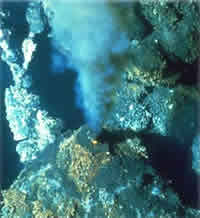 Black "smoke" from entrained particles flowing from Monolith Vent at North Cleft. Click for full size. |
VENTS Suspended Matter Project
Dr. Joe Resing - Principal Investigator
The primary objective of the VENTS Suspended Matter Project is to quantitatively assess the effects of submarine hydrothermal venting from Juan de Fuca and East Pacific Rise ridgecrest systems on the ocean chemistry of the Pacific Ocean. The program is designed to determine the relationships between the magnitude of the hydrothermal emission signal and the regional distribution, transport and temporal variability of conservative and nonconservative chemical species over distances up to several tens to hundreds of kilometers away from the ridge axis. Studies of the chemistry of hydrothermal precipitates at the vent fields on the Southern Juan de Fuca Ridge and Southern East Pacific Rise delineated the relationships between magmatic heat supply, hydrothermal cooling, and hydrothermal plume extent over the ridge axis.
Recent results from the Southern East Pacific Rise indicate that hydrothermal scavenging processes between 10° and 30°S remove approximately 6 - 25% of the total hydrothermal phosphorus sink in the oceans. Plume inventories of particulate phosphorus on the SEPR were as much as 15 - 100 times higher than had been observed on any other hydrothermal vent field on the global ridgecrest system. This means that the Southern East Pacific Rise between 10° and 30°S is the center of the most robust hydrothermal system on the surface of the planet.
EOI Particle Research in the Eastern Tropical Pacific:
CLIVAR
